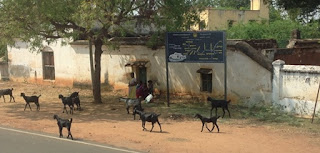The Church in Southern India
 |
| Wild goats are a common sight in India. |
The caste system has not gone away. All Indians must carry a caste certificate,
but many from lower castes have changed their religion from Hindu to Islam,
Buddhism and Christianity, as a way of escaping its worst aspects. You can gloss over one’s caste by saying that
you are a Christian, take any job, worship in any church and marry another
Christian.
The vast majority of marriages, even Christian marriages, are
arranged. Young men and women do not
socialise and dating is frowned upon.
Parents find husbands/wives by searching ‘matrimonial’ classifieds in
newspapers and on the internet.
Christian marriages take place in church, with no civil ceremony
required, and the groom is ‘allowed’ to appear in a suit, although the bride
will wear a sari. If the bridge and
groom are from different faiths, she is expected to convert to his
religion.
In India you wear your religion like a football scarf, with,
perhaps, a Cross or a ‘Jesus is Lord’ emblazoned across your car
windscreen. Our tour bus had ‘Maasha
Allah’ painted on the front.
 |
| Rice Boat in backwaters of Kerala. |
Several days into our tour, our British tour manager, M, was
stricken with acute stomach pains, necessitating many trips to the doctor, then
to the hospital. D, our local guide, who hadn’t known M until the start of our
tour, accompanied him to all these visits, staying up all night with him in
hospital until a decision was made to carry out surgery. The following day, without sleep, D did M’s
job as well as his own, taking us out on our day’s schedule of touring, with
good humour and enthusiasm, and, in fact, D continued to lead us by himself for
the rest of our holiday. D is an Indian Christian. D is a modern Good Samaritan. The Church of Southern India is alive and visible
and not just through its magnificent buildings.
What an amazing cue for our next ACW competition, which we are
about to launch in association with Street
Pastors. For this comp, you may
enter a piece of fiction or non-fiction on Today’s
Good Samaritans. As this is an open
competition, an entry fee will be chargeable.
More details in the spring edition of Christian Writer.
[1] "Population
by religious community - 2011".
2011 Census of India. Office of the Registrar General
& Census Commissioner. Archived from the
original on 25
August 2015. Retrieved 25 August 2015.
What an interesting post. Thank you.
ReplyDeleteThank you, Aggie. Next time I will try and write something properly about writing!
DeleteThank you for this post, Rosemary. Your view of Southern India is very interesting. I have recently returned from two weeks in Kerala. The Catholic churches we saw were huge, grand affairs. Could this be a cultural approach, an unconscious continuation of the caste system - God is so great He needs a palatial place for people to meet in? We passed a RC church one Saturday, where an Indian Christian wedding was about to start. The bride wore a beautiful long white dress, the groom a suit. I would have loved to know their story - did they know each other already? Was it an arranged marriage? Our guide was a local Christian who talked about his own arranged marriage. He spoke about falling in love with his wife after they were married, and they are now the delighted parents of a small son.
ReplyDeleteHow amazing that we were both in Southern India at the same time, Veronica! I also was struck by the grandeur and beauty, particularly, of the Catholic churches. I understand that Syrian Christians settled in Kerala some 600 years ago, that Keralans go back to work in Arab countries (obviously not to Syria), earn lots of money and spend some of it on their churches. The Anglican churches tended to be understated, or, to put it another way, in disrepair, presumably neglected after the end of the Raj, although building work was taking place in many of them when we visited.
DeleteWhat an inspiring trip! It also reminds me that I have much to be grateful for. Thanks for sharing it with us, Rosemary.
ReplyDeleteYes, I was shocked by how ingrained the caste system still was and by arranged marriages amongst Christians.
DeleteThank you for a fascinating post Rosemary. For those of us who read this in an email digest, can you please put your name in the title or a bio at the bottom so we don't have to go to the web to find out who we're reading?
ReplyDelete